Passively Q-Switched KTA Cascaded Raman Laser with 234 and 671 cm−1 Shifts
Abstract
:1. Introduction
2. Experimental Setup
3. Results and Discussion
4. Conclusions
Author Contributions
Funding
Institutional Review Board Statement
Informed Consent Statement
Data Availability Statement
Conflicts of Interest
References
- Powers, P.E.; Ramakrishna, S.; Tang, C.L.; Cheng, L.K. Optical parametric oscillation with KTiOAsO4. Opt. Lett. 1993, 18, 1171–1173. [Google Scholar] [CrossRef]
- Zhu, H.Y.; Guo, J.H.; Duan, Y.M.; Zhang, J.; Zhang, Y.C.; Xu, C.W.; Wang, H.Y.; Fan, D.Y. Efficient 1.7 μm light source based on KTA-OPO derived by Nd:YVO4 self-Raman laser. Opt. Lett. 2018, 43, 345–348. [Google Scholar] [CrossRef]
- Zhong, K.; Yao, J.Q.; Xu, D.G.; Wang, J.L.; Li, J.S.; Wang, P. High-pulse-energy high-efficiency midinfrared generation based on KTA optical parametric oscillator. Appl. Phys. B 2010, 100, 749–753. [Google Scholar] [CrossRef]
- Duan, Y.M.; Zhu, H.Y.; Xu, C.W.; Ruan, X.K.; Cui, G.H.; Zhang, Y.J.; Tang, D.Y.; Fan, D.Y. Compact self-cascaded KTA-OPO for 2.6 μm laser generation. Opt. Express 2016, 24, 26529–26535. [Google Scholar] [CrossRef] [PubMed]
- Watson, G.H. Polarized Raman spectra of KTiOAsO4 and isomorphic nonlinear-optical crystals. J. Raman Spectrosc. 1991, 22, 705–713. [Google Scholar] [CrossRef]
- Liu, Z.; Wang, Q.; Zhang, X.; Zhang, S.; Chang, J.; Cong, Z.; Sun, W.; Jin, G.; Tao, X.; Sun, Y.; et al. A diode side-pumped KTiOAsO4 Raman laser. Opt. Express 2009, 17, 6968–6974. [Google Scholar] [CrossRef] [PubMed]
- Guo, J.H.; Duan, Y.M.; Wang, H.Y.; Zhu, H.Y.; Wei, P.F.; Zhang, J.; Zhao, L.M.; Tang, D.Y. Efficient Nd:YAG\KTiOAsO4 cascaded Raman laser emitting around 1.2 μm. Opt. Mater. 2017, 71, 66–69. [Google Scholar] [CrossRef]
- Piper, J.A.; Pask, H.M. Crystalline Raman Lasers. IEEE J. Sel. Top. Quantum Electron. 2007, 13, 692–704. [Google Scholar] [CrossRef]
- Sheng, Q.; Ma, H.; Li, R.; Wang, M.; Shi, W.; Yao, J. Recent progress on narrow-linewidth crystalline bulk Raman lasers. Results Phys. 2020, 17, 103073. [Google Scholar] [CrossRef]
- Gong, X.H.; Zhu, H.Y.; Chen, Y.J.; Huang, J.H.; Lin, Y.F.; Luo, Z.D.; Huang, Y.D. Nd3+ Cluster Adjustment in Nd3+:CaNb2O6 by Codoping La3+ Buffers for Improvement of Fundamental and Self-Stimulated Raman Scattering Laser Operation: A Study Case from the Perspective of Defect Chemistry. Cryst. Growth Des. 2019, 19, 6963–6971. [Google Scholar] [CrossRef]
- Zhang, L.; Duan, Y.M.; Mao, X.H.; Li, Z.H.; Chen, Y.X.; Zhang, Y.J.; Zhu, H.Y. Passively Q-switched YVO4 Raman operation with 816 and 890 cm−1 shifts by respective Raman configurations. Opt. Mater. Express 2021, 11, 1815–1823. [Google Scholar] [CrossRef]
- Liu, Y.C.; Chen, C.M.; Hsiao, J.Q.; Pan, Y.Y.; Tsou, C.H.; Liang, H.C.; Chen, Y.F. Compact efficient high-power triple-color Nd:YVO4 yellow-lime-green self-Raman lasers. Opt. Lett. 2020, 45, 1144–1147. [Google Scholar] [CrossRef] [PubMed]
- Sun, Y.L.; Duan, Y.M.; Zhang, L.; Yang, Z.Y.; Chen, X.; Huang, X.H.; Zhu, H.Y. Efficient actively Q-switched Nd:YAP/YVO4 Raman laser operation at 1195nm. J. Russ. Laser Res. 2020, 41, 373–377. [Google Scholar] [CrossRef]
- Liu, Z.J.; Rao, H.; Cong, Z.H.; Xue, F.; Gao, X.B.; Wang, S.; Tan, W.; Guan, C.; Zhang, X.Y. Single-frequency BaWO4 Raman MOPA at 1178 nm with 100-ns pulse pump. Crystals 2019, 9, 185. [Google Scholar] [CrossRef] [Green Version]
- Duan, Y.M.; Zhu, H.Y.; Zhang, G.; Huang, C.H.; Wei, Y.; Tu, C.Y.; Zhu, Z.J.; Yang, F.G.; You, Z.Y. Efficient 559.6 nm light produced by sum-frequency generation of diode-end-pumped Nd:YAG/SrWO4 Raman laser. Laser Phys. Lett. 2010, 7, 491–494. [Google Scholar] [CrossRef]
- Chen, Y.F.; Huang, H.Y.; Lee, C.C.; Hsiao, J.Q.; Tsou, C.H.; Liang, H.C. High-power diode-pumped Nd:GdVO4/KGW Raman laser at 578 nm. Opt. Lett. 2020, 45, 5562–5565. [Google Scholar] [CrossRef]
- Sheng, Q.; Lee, A.; Spence, D.; Pask, H. Wavelength tuning and power enhancement of an intracavity Nd:GdVO4-BaWO4 Raman laser using an etalon. Opt. Express 2018, 26, 32145–32155. [Google Scholar] [CrossRef] [PubMed] [Green Version]
- Yu, H.H.; Li, Z.; Lee, A.J.; Li, J.; Zhang, H.J.; Wang, J.Y.; Pask, H.M.; Piper, J.A.; Jiang, M.H. A continuous wave SrMoO4 Raman laser. Opt. Lett. 2011, 36, 579–581. [Google Scholar] [CrossRef] [PubMed]
- Tu, C.S.; Guo, A.R.; Tao, R.W.; Katiyar, R.S.; Guo, R.Y.; Bhalla, A.S. Temperature dependent Raman scattering in KTiOPO4 and KTiOAsO4 single crystals. J. Appl. Phys. 1996, 79, 3235–3240. [Google Scholar] [CrossRef]
- Duan, Y.M.; Zhu, H.Y.; Zhang, Y.J.; Zhang, G.; Zhang, J.; Tang, D.Y.; Kaminskii, A.A. RbTiOPO4 cascaded Raman operation with multiple Raman frequency shifts derived by Q-switched Nd:YAlO3 laser. Sci. Rep. 2016, 6, 33852. [Google Scholar] [CrossRef] [PubMed] [Green Version]
- Liu, Z.J.; Wang, Q.P.; Zhang, X.Y.; Zhang, S.S.; Chang, J.; Wang, H.; Fan, S.Z.; Sun, W.J.; Tao, X.T.; Zhang, S.J.; et al. 1120 nm second-Stokes generation in KTiOAsO4. Laser Phys. Lett. 2008, 6, 121–124. [Google Scholar] [CrossRef]
- Lan, W.X.; Wang, Q.P.; Liu, Z.J.; Zhang, X.Y.; Bai, F.; Shen, H.B.; Gao, L. A diode end-pumped passively Q-switched Nd:YAG/KTA Raman laser. Optik 2013, 124, 6866–6868. [Google Scholar] [CrossRef]
- Huang, Y.J.; Chen, Y.F.; Chen, W.D.; Zhang, G. Dual-wavelength eye-safe Nd:YAP Raman laser. Opt. Lett. 2015, 40, 3560–3563. [Google Scholar] [CrossRef]
- Liu, Z.; Wang, Q.; Zhang, X.; Zhang, S.; Chang, J.; Fan, S.; Sun, W.; Jin, G.; Tao, X.; Sun, Y.; et al. Self-frequency-doubled KTiOAsO4 Raman laser emitting at 573 nm. Opt. Lett. 2009, 34, 2183–2185. [Google Scholar] [CrossRef] [PubMed]
- Zhu, H.Y.; Shao, Z.H.; Wang, H.Y.; Duan, Y.M.; Zhang, J.; Tang, D.Y.; Kaminskii, A.A. Multi-order Stokes output based on intra-cavity KTiOAsO4 Raman crystal. Opt. Express 2014, 22, 19662–19667. [Google Scholar] [CrossRef]
- Duan, Y.; Zhu, H.; Wang, H.; Zhang, Y.; Chen, Z. Comparison of 1.15 µm Nd:YAG\KTA Raman lasers with 234 and 671 cm−1 shifts. Opt. Express 2016, 24, 5565–5571. [Google Scholar] [CrossRef] [PubMed]
- Pask, H.M.; Dekker, P.; Mildren, R.P.; Spence, D.J.; Piper, J.A. Wavelength-versatile visible and UV sources based on crystalline Raman lasers. Prog. Quantum Electron. 2008, 32, 121–158. [Google Scholar] [CrossRef]
- Runcorn, T.H.; Gorlitz, F.G.; Murray, R.T.; Kelleher, E.J.R. Visible Raman-Shifted Fiber Lasers for Biophotonic Applications. IEEE J. Sel. Topics Quantum Electron. 2018, 24, 2770101. [Google Scholar] [CrossRef] [Green Version]
- Chang, Y.T.; Huang, Y.P.; Su, K.W.; Chen, Y.F. Diode-pumped multi-frequency Q-switched laser with intracavity cascade Raman emission. Opt. Express 2008, 16, 8286–8291. [Google Scholar] [CrossRef]
- Ye, P.P.; Zhu, S.Q.; Li, Z.; Yin, H.; Zhang, P.X.; Fu, S.H.; Chen, Z.Q. Passively Q-switched dual-wavelength green laser with an Yb:YAG/Cr4+:YAG/YAG composite crystal. Opt. Express 2017, 25, 5179–5185. [Google Scholar] [CrossRef]
- Duan, Y.; Zhang, J.; Zhu, H.; Zhang, Y.; Xu, C.; Wang, H.; Fan, D. Compact passively Q-switched RbTiOPO4 cascaded Raman operation. Opt. Lett. 2018, 43, 4550–4553. [Google Scholar] [CrossRef] [PubMed]
- Dascalu, T.; Croitoru, G.; Grigore, O.; Pavel, N. High-peak-power passively Q-switched Nd:YAG/Cr4+:YAG composite laser with multiple-beam output. Photon. Res. 2016, 4, 267–271. [Google Scholar] [CrossRef]
- Frank, M.; Smetanin, S.N.; Jelínek, M.; Vyhlídal, D.; Kopalkin, A.A.; Shukshin, V.E.; Ivleva, L.I.; Zverev, P.G.; Kubeček, V. Synchronously-pumped all-solid-state SrMoO4 Raman laser generating at combined vibrational Raman modes with 26-fold pulse shortening down to 1.4 ps at 1220 nm. Opt. Laser Technol. 2019, 111, 129–133. [Google Scholar] [CrossRef]
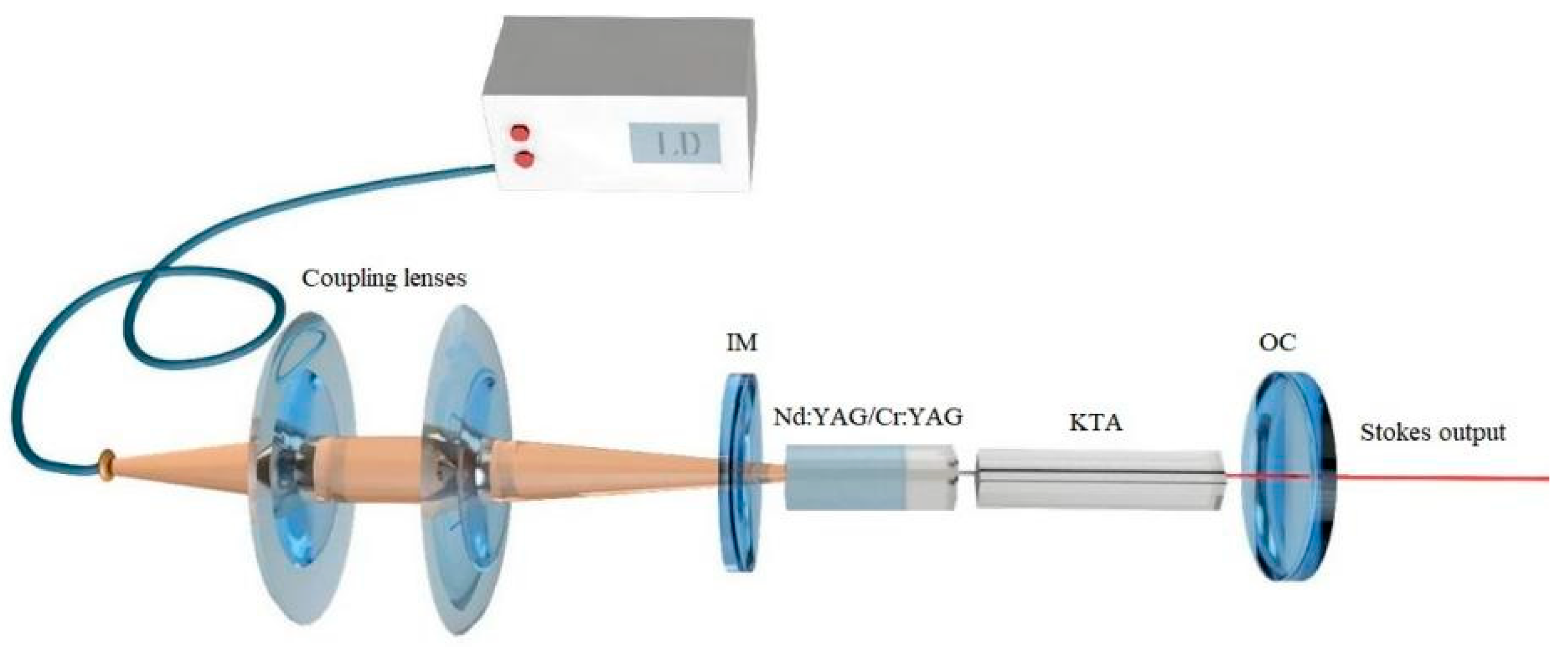
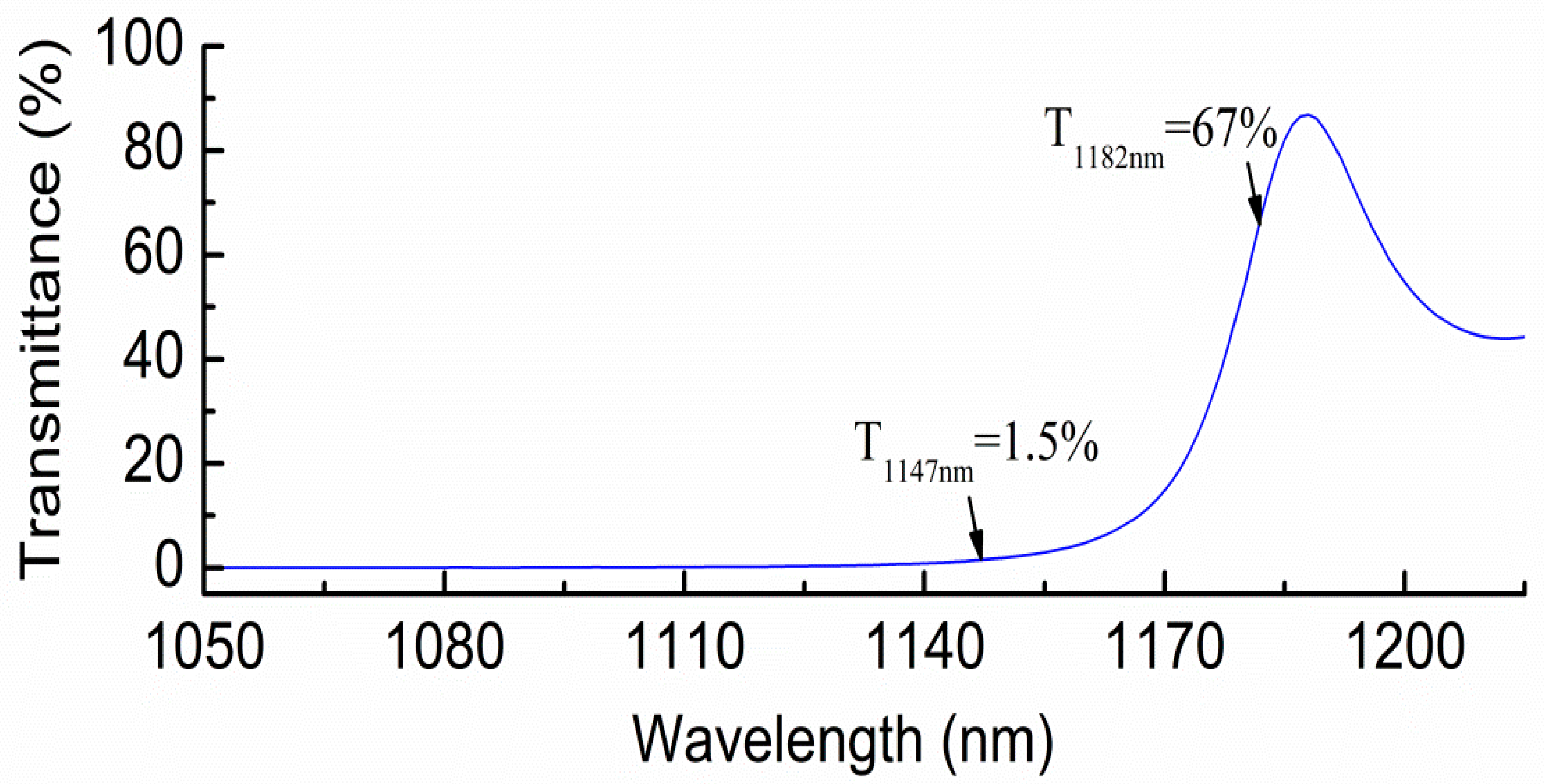
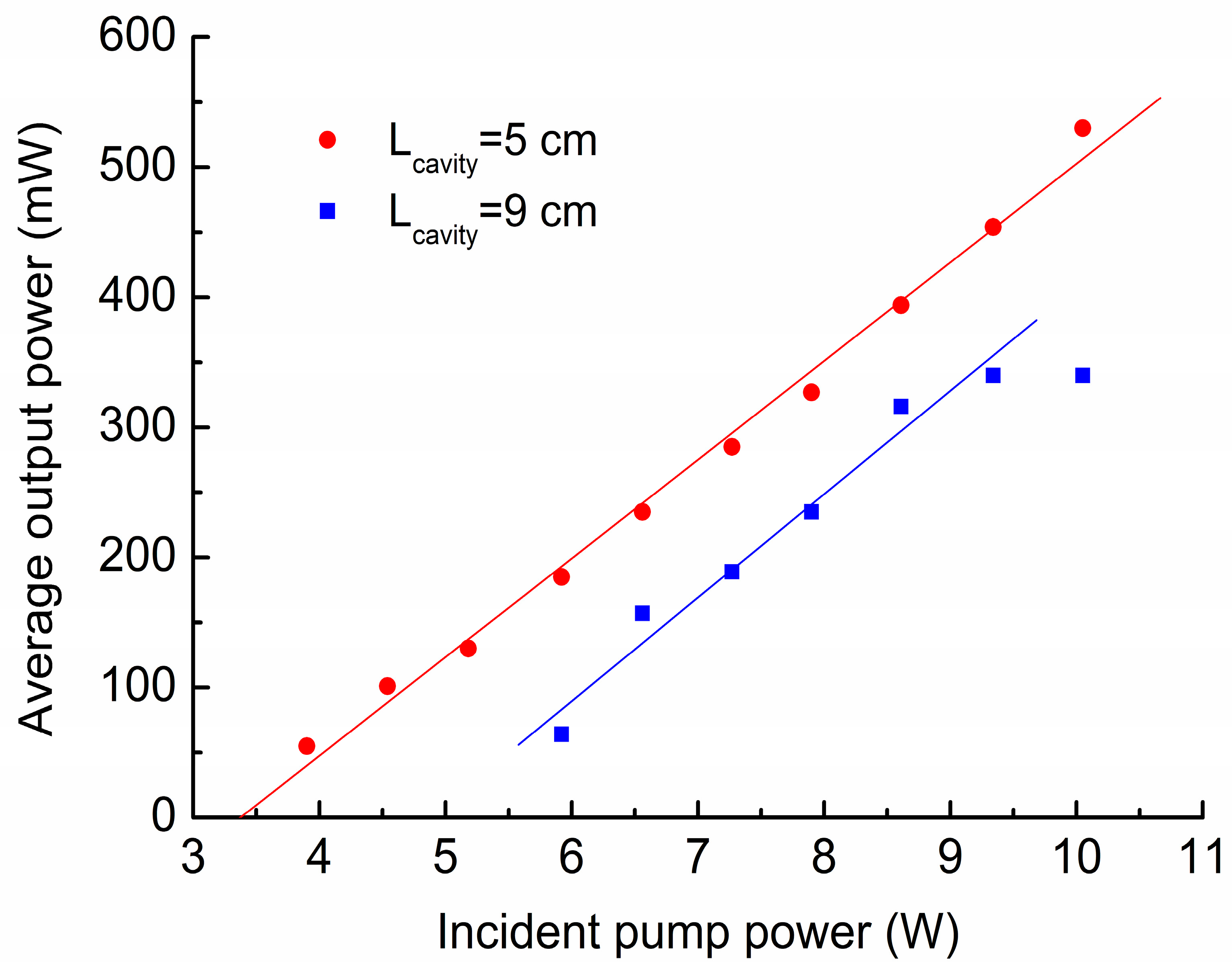
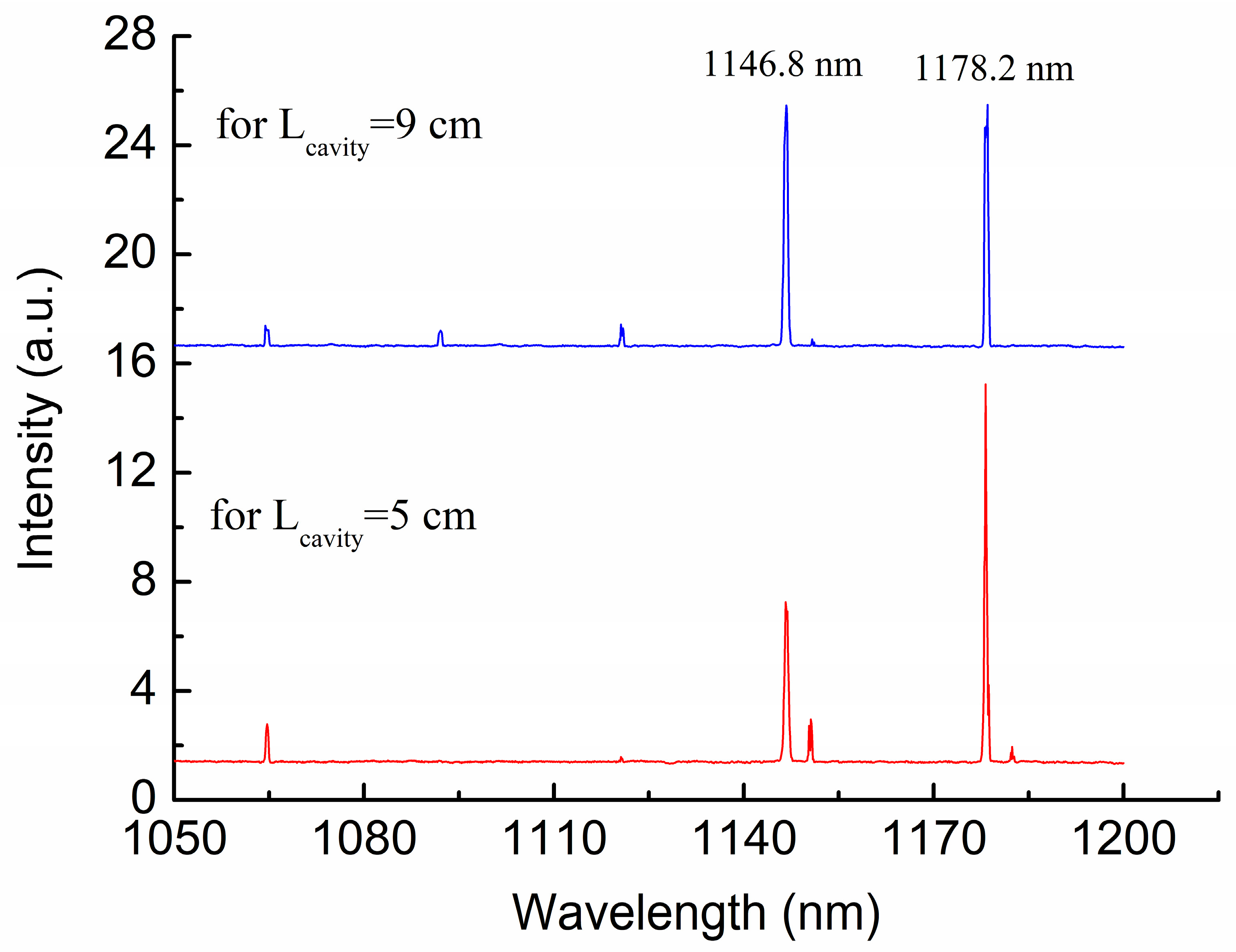
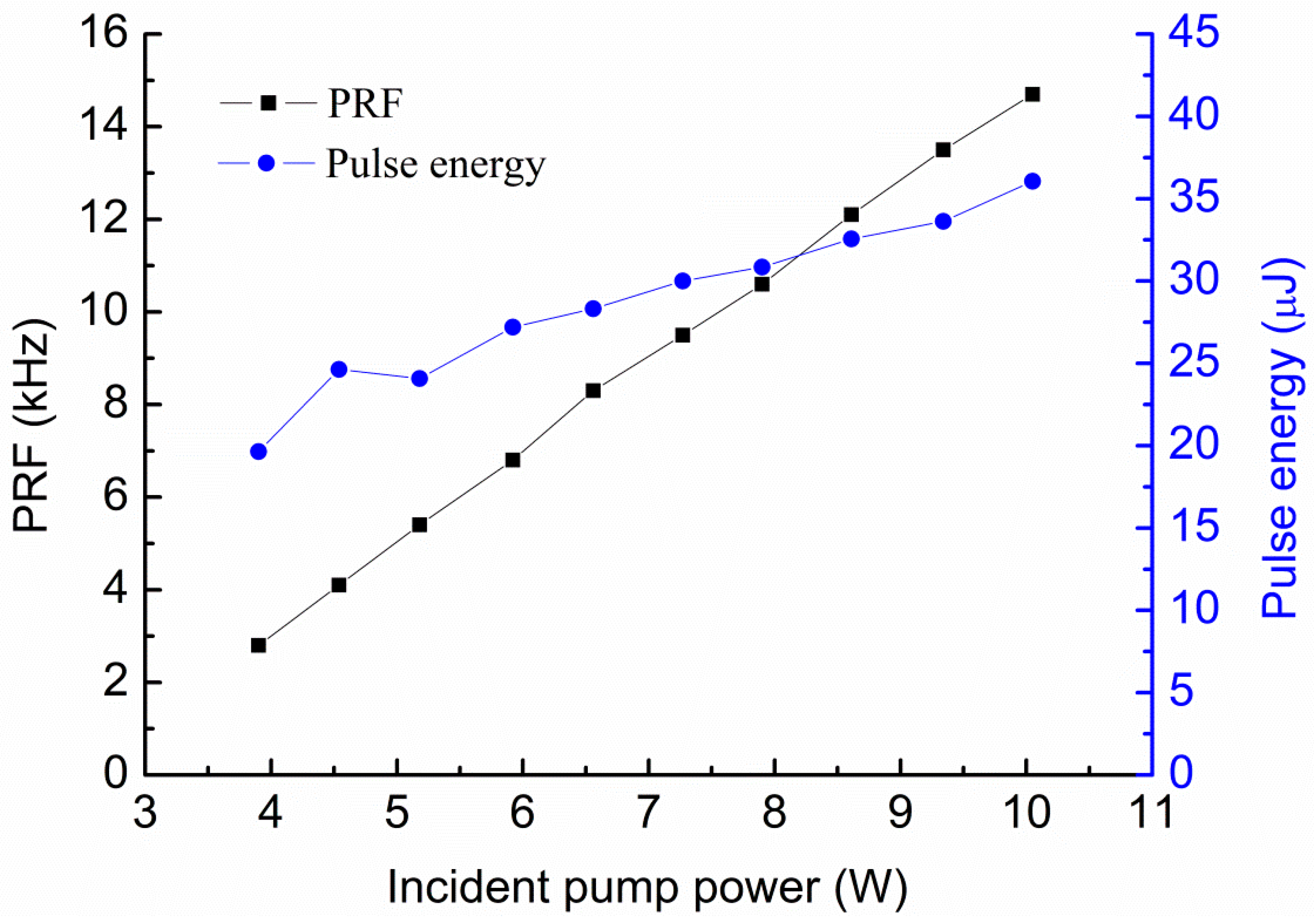
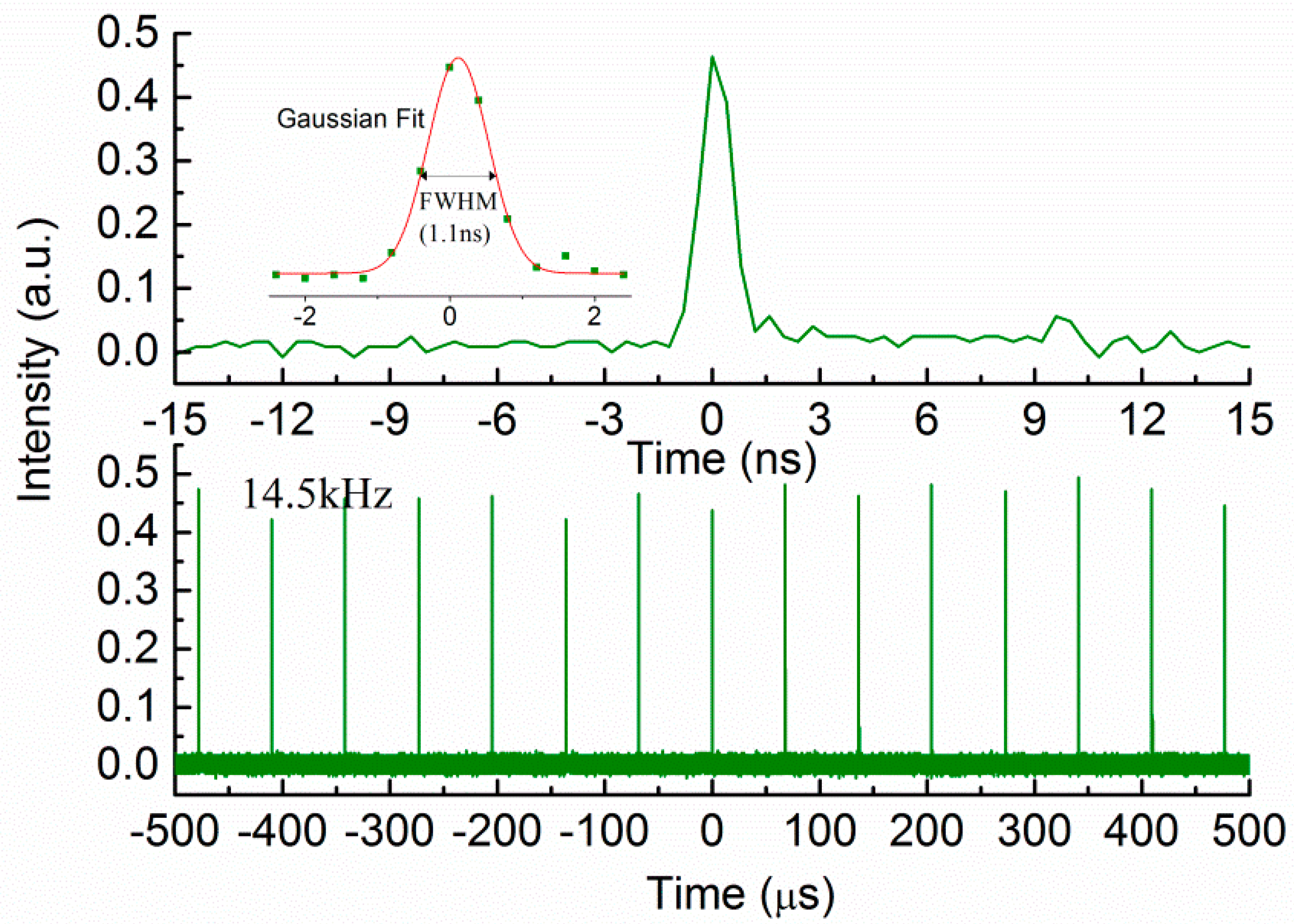
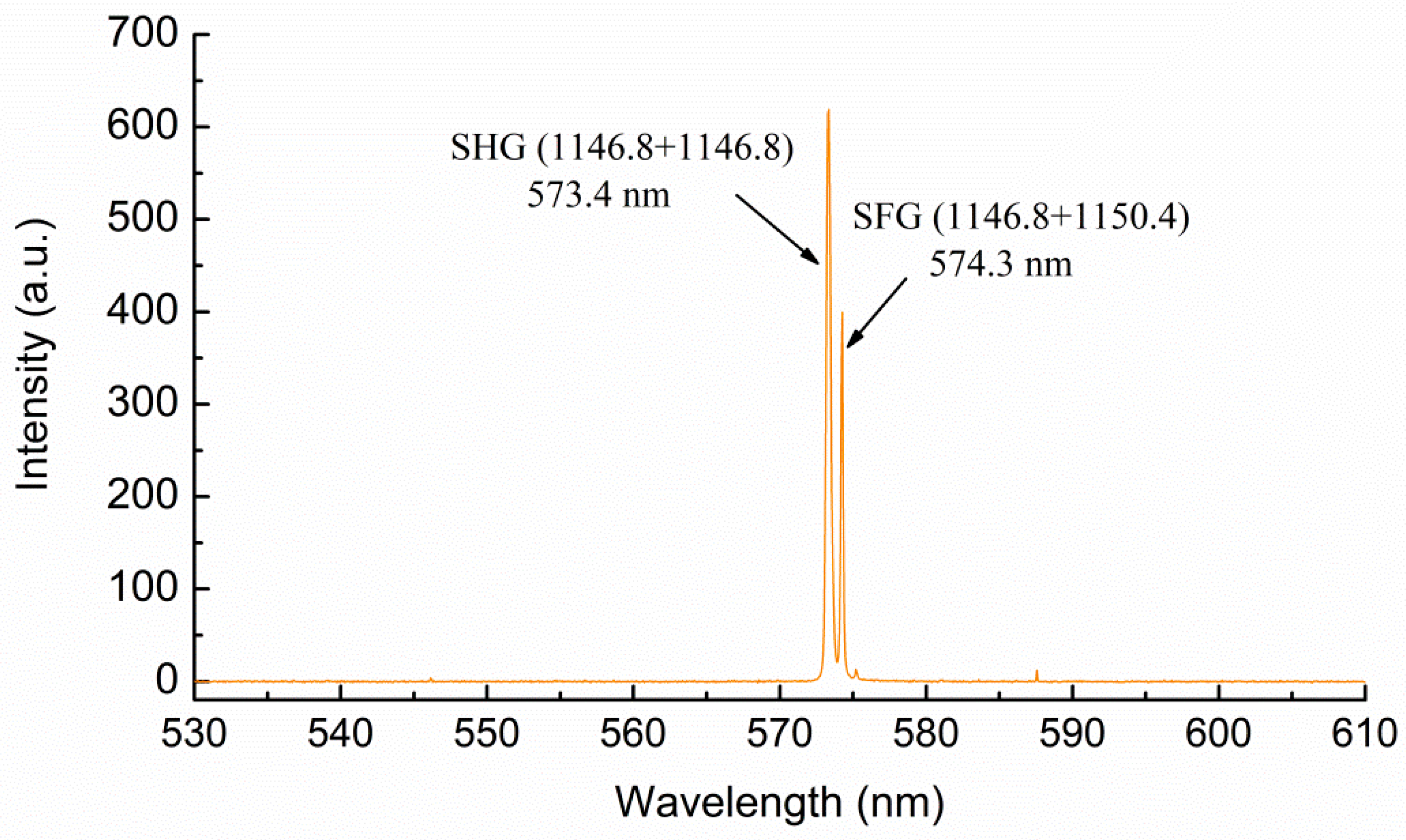
| Wavelength (nm) | Contributed Raman Shifts ωR1 = 234 cm−1, ωR2 = 671 cm−1 |
|---|---|
| 1092.0 | ωR1 |
| 1120.7 | 2ωR1 |
| 1146.8 | ωR2 |
| 1150.4 | 3ωR1 |
| 1178.2 | ωR2 + ωR1 |
| 1182.4 | 4ωR1 |
Publisher’s Note: MDPI stays neutral with regard to jurisdictional claims in published maps and institutional affiliations. |
© 2021 by the authors. Licensee MDPI, Basel, Switzerland. This article is an open access article distributed under the terms and conditions of the Creative Commons Attribution (CC BY) license (https://creativecommons.org/licenses/by/4.0/).
Share and Cite
Xie, Z.; Lou, S.; Duan, Y.; Li, Z.; Chen, L.; Wang, H.; Zhang, Y.; Zhu, H. Passively Q-Switched KTA Cascaded Raman Laser with 234 and 671 cm−1 Shifts. Appl. Sci. 2021, 11, 6895. https://doi.org/10.3390/app11156895
Xie Z, Lou S, Duan Y, Li Z, Chen L, Wang H, Zhang Y, Zhu H. Passively Q-Switched KTA Cascaded Raman Laser with 234 and 671 cm−1 Shifts. Applied Sciences. 2021; 11(15):6895. https://doi.org/10.3390/app11156895
Chicago/Turabian StyleXie, Zhi, Senhao Lou, Yanmin Duan, Zhihong Li, Limin Chen, Hongyan Wang, Yaoju Zhang, and Haiyong Zhu. 2021. "Passively Q-Switched KTA Cascaded Raman Laser with 234 and 671 cm−1 Shifts" Applied Sciences 11, no. 15: 6895. https://doi.org/10.3390/app11156895
APA StyleXie, Z., Lou, S., Duan, Y., Li, Z., Chen, L., Wang, H., Zhang, Y., & Zhu, H. (2021). Passively Q-Switched KTA Cascaded Raman Laser with 234 and 671 cm−1 Shifts. Applied Sciences, 11(15), 6895. https://doi.org/10.3390/app11156895







